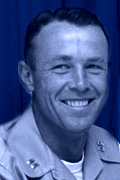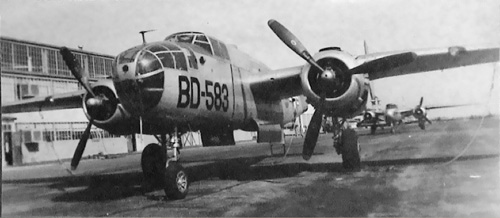Chapter 3 >
Autobiography home >
NF-104 home

Chapter 3 - Flight Test click on the links below for more of the story...
|
||
|
It's Academic I had voluntarily given up fighter operations as a way of life, one I dearly loved, to spend two years studying aeronautical engineering, with little flying, but with the hope of becoming an experimental test pilot in the future. I flew my last tactical flight for many years, when I flew at Kirtland on 5 August 53. Big dreams require big gambles and this was both, but not without trepidation. I learned that my friend and greatest pilots I ever flew with, Kenny Chandler had crashed into a mountain on an instrument letdown, almost exactly as it happened to our idol as cadets, Lefty Selinger. One could never assume that pilot error was the cause, since weather flying was far more dangerous in those times for the jet fighter pilot, usually without sufficient fuel to make alternate airports, very limited instrumentation, poor navigational aids and no suitable or published jet let-down procedures at most destinations. Where there was no published descent, we generally made a sort of teardrop, steep diving descent from an ADF station, off airways and often self invented by assessing the topography of the area. Controllers were so unfamiliar with the needs and capabilities of jet fighters that they were seldom aware of our situation, especially our need to spend very little time at low altitude. They would like as not direct us to stay in some distant holding pattern at low altitude, until we were in emergency situations. Unfortunately those kinds of circumstances took a number of capable and fine pilots, like these two outstanding airmen. Martha, the kids and I moved into Air Force housing, near Wright Field, the site of the Air Force Institute of Technology, AFIT campus. The quarters were apartments on two floors joined in strings, which circled common grounds. Overall, that development covered a very large area. Two years there proved to be good for our family, since there were lots of children, while the friends and the neighbors had common interests, as with all base life. It was an especially fine atmosphere for raising children in the old mode, where neighbors kept track, helped and were not hesitant to report to one another. AFIT had a reputation for excellent undergraduate electrical and aeronautical undergraduate studies and graduate degrees in specialty engineering, other science and administration associated with the Air Force mission. Our class had 48 students in two sections with common subjects for the first year and then split into electrical or aeronautical options. AFIT officials realized that many students had not been in college for some years and would suddenly be in advanced courses as juniors. We had an intensive 6-day, 6-week refresher in mathematics: algebra, plane and solid geometry, trigonometry, analytical geometry and undergrad calculus, without which I would have been lost. I hadn’t realized how my interest in the cockpit had pushed all of that into my sub-conscious in such a short span since high school and college. The AFIT mathematics staff was superior, and being my favorite, along with physics, I took as many of those courses as possible, which were invaluable in some of the graduate courses we were offered in aeronautics. There was so much difference in my attitude to the subjects, when compared to studies in those years of youth, because there was reality to the subjects, a part of my future life, I hoped.
Flying for the first year was limited to C-45 transports and B-25 bombers, but that provided my first experience in multi-engine aircraft. In my second year, we got T-33s, the two-seat version of the F-80 jets, which helped me regain some proficiency. Flying was an infrequent diversion from education but I did have a bit of sport from time to time. For example, another student Capt. Dick Miller, also a fighter pilot, and I decided to try rat racing and scheduled 2 B-25s, with a couple of classmates as co-pilots. A full colonel approached to join me and sit in the jump seat behind us so he could log “command pilot” time. It was agreeable, if he concurred in the aerial dogfight and he said that would be O.K., but his stomach didn’t get the word. He threw up, but the maneuvers continued. I discovered that it was hard work trying to make that bomber act like a fighter. Just flying close formation was an arm twister, compared to the easy response of a fighter’s controls. I figured those B-17 and B-24 jocks built up arm muscles on long combat formations, just by staying in spread combat positions. Very few of our classmates showed up in my future, but Dick was one of them. When I was at Edwards AFB later, he had gone there to work as an engineering/manager for Lockheed. Another, Capt. Alton “Ike” Eichelkraut and wife, Fran, were neighbors in Denver after I retired to civilian work and they have been pen pals, ever since. Quite frankly our social life in AFIT was very limited due to family and the academic pressure. Having completed two year of college prior to that, I found that the professors at AFIT, who were used to only dealing with professional officers whose chosen careers were dependent upon their success, didn’t spare us, placing severe demands on our study time. The best example was, Maj. Howard Lane who worked hardest of all to complete the course and would spend all his waking hours studying, and with few sleeping hours. Near the end of two years there were times he seemed to slip into another world. Work and dedication prevailed, and years later, he commanded the Air Force Flight Test Center, and achieved Lt. General, before retiring. I would cite him as one of the hardest working guys that I ever met, anywhere. In our senior year we were offered graduate level electives. In one aeronautical engineering course I received a lousy grade on a test from Dr. Gunther Graetzer, head of the Aeronautical Engineering Department because my analysis didn’t suit his approach, though the results proved correct. I had used a mathematical three dimensional vector analysis and was convinced it was correct and accurate. He refused to accept it so, being a maverick, I took the issue to one of our finest and brightest instructors, Dr. Leno Pedrotti, Physics Department. Leno, himself a young maverick, confirmed my work, and courageously discussed it with Herr Doctor, who recanted and gave me full grade. Fortunately I didn’t have too much time left to go, but enough for fallout to hit and was reminded about winning battles and losing wars. That kind of lesson never did stick for long with me, even though it wasn’t the best military attitude. Our neighbor in the Wherry Housing project, 2/Lt. Forrest McCartney, could be counted on to tutor me with advanced math courses, always my choice electives. Forrest was a graduate student in nuclear engineering and an intelligent young man, who ultimately achieved Lt. General rank. He is a gentleman of the old south, who still lives near the Cape with his wife ‘Miss Jane’. He commanded Kennedy Space Center years later, when I was the V.P. and General Manager of the Shuttle External Tank Program, for Martin Marietta Corporation, after I retired from the service. I graduated from AFIT with a lot better understanding of airplanes and flight than I would ever have gained any other way, and that education was the best of my life. It was tailor made for at least three of my future assignments, and greatly enhanced my future after I retired from the service. We graduated in September 1955 and because I had already applied and been selected for Test Pilot School, I was temporarily assigned to the test unit at Wright-Patterson and enjoyed being back in the cockpit, and flew 80 hours in two months. It was great, after so little flying for two years, to climb back into fighters, F-80C and F-86. I also flew 3 flights in the reliable old C-47, Gooney Bird, my last time in that venerable airplane. Jimmy Joe Butler, who later would fly F-105’s in Vietnam, as I did, was chief of fighters, and facilitated my regaining proficiency. The “testing” was rather mundane, but a far cry from flying around the flag pole in the T-33, C-45 and B-25 of the preceding two years. One project raised the adrenaline level for the first time in a couple of years. I flew an instrumented T-33 to Albuquerque to do some calibration of equipment for FAA, flying in tandem with a T-299 We were testing out of Albuquerque, and I had to fly to Hill AFB, near Salt Lake City. The weather was cloudy the entire route, even to altitudes above 30,000 feet, but destination was 3000 foot ceilings. No sweat, I thought. There was no alternate airport within range when I would get there but that was not abnormal in those days, and I could turn back, at least until reaching a point of no return. A civilian of the test team asked to go along for his first jet ride, which was permissible, since he was on flight observer orders. When I was a couple of hundred miles from destination and flying on instruments, and well beyond any return, I suddenly lost all navigation aids and the radios. We were low on fuel because of winds, but the last calculated winds indicated we had enough to go a bit further west, beyond the Salt Lake to the flatlands, then make letdown, avoiding the mountains to the east of the base, which certainly were sticking high up in the clouds where we would normally let down. Since I had no navigation aids the critical need was to be past the mountain peaks. We sure weren’t equipped to bail out in the snowy terrain and survive, a risk frequently faced by fighter pilots, who were seldom outfitted for that eventuality in the states, even in single engine aircraft. I flew west as long as I dared in order to achieve maximum margin away from the mountains but trading against another risk because of fuel state and the need to fly back to the base at low altitude, burning lots of fuel under the clouds. I started the blind letdown, and there was no point in sharing the concern with my passenger. We broke out of a heavy cloud cover east of the base and with snow covered mountain peaks surrounding us, poking into those clouds we just exited. Once safely below, it was easy flying visually between them to reach the base and land. It was obvious that the headwinds had grown severe in the late stages of our flying at altitude. A memorable note was the response of my passenger, which was one of awe and amazement at the beauty of the scene when we broke out among the mountains. It was a fabulous view and he had no inkling of peril, and I never spoiled his impression. Finally, the big day arrived and I received orders to the Air Force Test Pilot School based at Edwards Air Force Base, California, words that were music to my ears. I had risked losing my enjoyable life as an operational fighter pilot just for that chance. Had I missed the opportunity for TPS after getting my degree, my life would have changed drastically into lots of technical assignments, but little flying. I owed Lady Luck my thanks; the old girl had come through for me once again. All four of us and our ever-faithful German shepherd, ‘Sabre’, headed for California, in our Ford Station Wagon, our first almost new car, a $2000 bargain with only 4000 miles on it when it’s owner transferred overseas. |
| next section |

